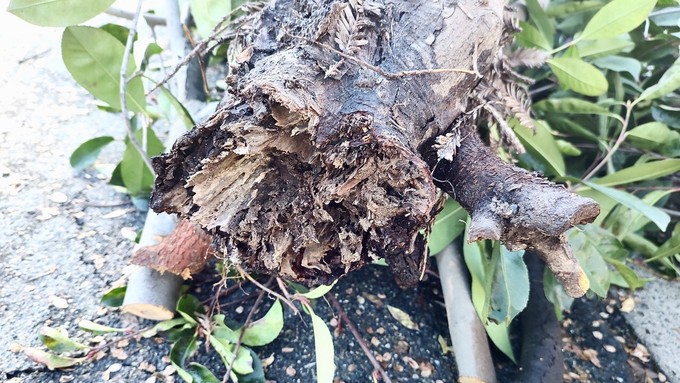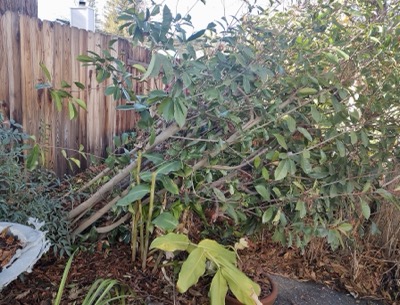
Hidden by too much ‘mulch,’ crown rot revealed by wind gust

With almost no roots left to hold it in place, this photinia fell over in Saturday's storm. Debbie Arrington
Why do trees (or large shrubs) suddenly fall during a big storm? The problem often lies at the roots.
Right after warning Sacramento Digs Gardening readers about trees that are leaning, I lost one of my 12-foot photinias. Blasted by wind, it fell over during Saturday’s storm.
This was a red-tip Fraser photinia – one of the most common hedge shrubs in Sacramento – and seemingly healthy. As an evergreen, it still had lots of foliage. And that canopy also was part of what led to its sudden downfall; the broad leaves apparently caught a sudden gust and that toppled the tree right over.
My first thought when I saw it: How do I get this big shrub up and stabilized? But this photinia was a goner.
On closer inspection, I discovered the photinia had snapped off at the base of its multi-trunks – it was a victim of crown rot. Only one healthy (albeit very thick) root had been holding the tree upright. There were signs of rot all around the crown (where the trunks meet the soil).
Unfortunately, it took the shrub falling over to reveal the rot. And I feel partly responsible.

Planted when our home was built in 1980, the photinia was under a gigantic coastal redwood that hangs over the fence and dumps loads of debris. That redwood litter had accumulated between the fence and the trunk of the photinia, mounding around the crown.
While the redwood litter mulched the shrub and helped it through drought, it also kept too much moisture around the crown, allowing fungal disease to take hold. (Yes, you can have too much mulch.)
Crown rot is caused by funguslike water molds, according to the UCANR pest notes. Above-ground signs of this infection include twig or branch dieback, undersized or discolored leaves and dropped foliage. Mature shrubs or trees infected by these molds grow slowly and gradually decline.
My photinia had shown some twig dieback, but I attributed this to the drought. It also grew much slower in recent years; for a shrub that needs regular pruning, I thought that was a good thing.
But now there’s a wide hole in my photinia hedge. While I couldn’t save the fallen photinia, I’m raking out that redwood debris from under the remaining shrubs so their crowns can dry out.
For more on crown rot: http://ipm.ucanr.edu/PMG/GARDEN/FRUIT/DISEASE/pchphytoph.html.
Comments
0 comments have been posted.Sacramento Digs Gardening to your inbox.
Sites We Like
Garden Checklist for week of July 21
Your garden needs you!
* Keep your vegetable garden watered, mulched and weeded. Water before 8 a.m. to reduce the chance of fungal infection and to conserve moisture.
* Feed vegetable plants bone meal, rock phosphate or other fertilizers high in phosphate to stimulate more blooms and fruiting. (But wait until daily high temperatures drop out of the 100s.)
* Don’t let tomatoes wilt or dry out completely. Give tomatoes a deep watering two to three times a week.
* Harvest vegetables promptly to encourage plants to produce more. Squash especially tends to grow rapidly in hot weather. Keep an eye on zucchini.
* Pinch back chrysanthemums for bushy plants and more flowers in September.
* Remove spent flowers from roses, daylilies and other bloomers as they finish flowering.
* Pinch off blooms from basil so the plant will grow more leaves.
* Cut back lavender after flowering to promote a second bloom.
* It's not too late to add a splash of color. Plant petunias, snapdragons, zinnias and marigolds.
* From seed, plant corn, pumpkins, radishes, winter squash and sunflowers.